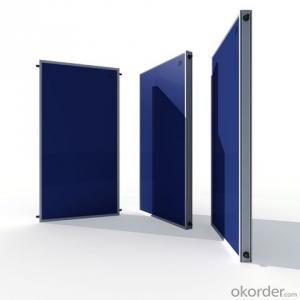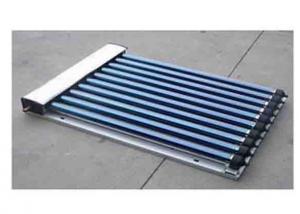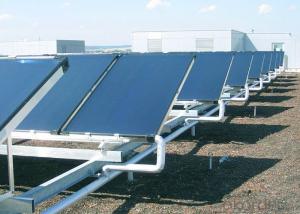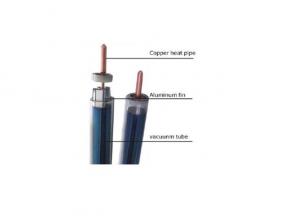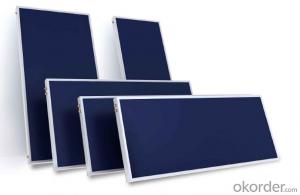CNBM Brand Solar Monocrystalline Series Panel
- Loading Port:
- Tianjin
- Payment Terms:
- TT OR LC
- Min Order Qty:
- 1 pallet
- Supply Capability:
- 100000000 pallet/month
OKorder Service Pledge
OKorder Financial Service
You Might Also Like
Solar Monocrystalline Series Panels

Product Description:
Introduction of Solar Monocrystalline Series Panels
CNBM Solar photovoltaic (PV) Panel is designed for large electrical power requirements. It is the optimal choice for both on-grid and off-grid power systems. CNBM Solar panel offers high performance of power per square foot of solar array. Monocrystalline silicon(c-Si): often made using the Czochralski process. Single-crystal wafer cells tend to be expensive, and because they are cut from cylindrical ingots, do not completely cover a square solar cell module without a substantial waste of refined silicon. Hence most c-Si panels have uncovered gaps at the four corners of the cells.
Characteristics of Solar Monocrystalline Series Panels
I Solar Cell : High efficiency crystalline solar cell. Even if under the weak light, the solar module can produce maximum power output.
II Tempered glass (toughened glass): Anti-reflecting coating and high transmission rate glass increase the power output and mechanical strength of solar module.
III EVA and TPT: Using high quality EVA and TPT to prevent destroying and water.
IV AI frame: Without screw, corner connection. 6 holes on the frame can be installed easily.
V Junction box: Multi function junction box with water proof.
VI Long lifetime: ≥25 years; Less power decrease
VII Good performance of preventing from atrocious weather such as wind and hails.
VIII Resisting moisture and etching effectively, not effected by geology.
Standard Test Conditions of Solar Monocrystalline Series Panels
The opto-electrical specifications shown below are stabilized values being measured at Standard Test Conditions, Irradiance: 1000W/m2, Spectrum: AM1.5 at 25°C, The info below is subject to manufacturing tolerances. Where appropriate minutes of measurement are available and are used for the dimensioning of the installation.
Advantages of Solar Monocrystalline Series Panels
• CNBM Solar performance guarantees for 25 years
• 12 years guarantee for workmanship
• Timeliness of delivery
CNBM International Corporation's products including Monocrystalline Solar Panel, Polycrystalline Solar Panel have received and enjoyed famous reputation in many countries and regions in the world .As a solar panel supplier in China, we strive to provide our customers with excellent service, superior products and unmatched value.
Characteristics of Solar Monocrystalline Series Panels
Max Power Voltage Vmp (V) | 18.4V | 17.6V |
Max Power Current Imp (A) | 6.52A | 7.39A |
Open Circuit Voltage Voc (V) | 23.0V | 22.2V |
Short Circuit Current Isc (A) | 6.97A | 7.90A |
Max Power Pm (W) | 120W | 130W |
Temperature Coefficient of Cells
NOCT | 47℃±2℃ |
Temperature Coefficients of Isc (%/℃) | 0.064 |
Temperature Coefficients of Voc (%/℃) | -0.33 |
Temperature Coefficients of Pmp (%/℃) | -0.45 |
Mechanical Data Solar Monocrystalline Series
Power | 120W/130W |
Dimension | 1190/1470×670×30mm |
Weight | 9.5kg/11.7kg |
Tolerance | ±3% |
The dimension of the modules can be changed according to the demand of clients
Limits
Operating Temperature | –40 °C to +85°C |
Storage Temperature | –40 °C to +85°C |
Max System Voltage | 700V |
Guarantee Solar Monocrystalline Series Panels
Products Guarantee | 10 yrs free from defects in materials and workmanship |
Performance Guarantee | No less than 90% within 10yrs and no less than 80% within 25yrs |
Certificates | IEC, ISO, TUV, CE |
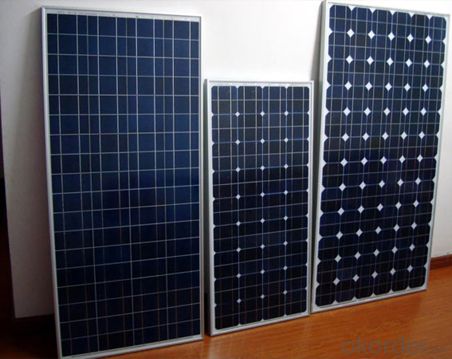
FAQ
I..Will you focus on the safety of the goods during transportation?
Yes, Safety of the cargo is the primary element that we would consider on transportation.
II..How would guarantee the quality will meet the requirements of your clients?
Before shipment, we will have inspection for each batch of goods.
III..What certificates do you have?
IEC,UL,TUV,CSA,etc.
IV..Can you do OEM according to clients’ requirements?
Yes, we have our own brand while we can provide OEM service.

- Q:What are the different types of solar collectors?
- There are three main types of solar collectors: flat plate collectors, evacuated tube collectors, and concentrating collectors.
- Q:How do solar collectors affect property value?
- Solar collectors can have a positive impact on property value. Installing solar collectors on a property can increase its attractiveness to potential buyers, as it demonstrates the homeowner's commitment to sustainability and renewable energy. Solar collectors provide a source of clean and renewable energy, which can lead to reduced energy costs for the homeowner. This financial benefit can also be appealing to potential buyers, as it can result in long-term savings on utility bills. Additionally, solar collectors may also qualify for various government incentives and tax credits, which can further enhance the property's value. Overall, the presence of solar collectors on a property can enhance its desirability and marketability, potentially increasing its value.
- Q:Are there any limitations to the size of a solar collector installation?
- Yes, there are limitations to the size of a solar collector installation. Some of the key limitations include the availability of suitable space, the capacity of the electrical grid to handle the generated energy, and the cost and efficiency of the system. Additionally, local zoning regulations and building codes may impose restrictions on the size and placement of solar collector installations.
- Q:What is the ideal tilt angle for a solar collector?
- The ideal tilt angle for a solar collector depends on the latitude of the location. Generally, for optimal energy production, the tilt angle of a solar collector should be set equal to the latitude of the area. This angle allows the collector to receive maximum direct sunlight throughout the year, maximizing its efficiency.
- Q:How do solar collectors affect the energy consumption of a building?
- Solar collectors can significantly reduce the energy consumption of a building. By harnessing the power of the sun, these collectors convert sunlight into usable energy, typically in the form of electricity or heat. This renewable energy source helps to decrease the dependence on fossil fuels and lowers the overall energy demand of the building. Consequently, solar collectors contribute to a more sustainable and environmentally friendly energy system, reducing both costs and carbon emissions.
- Q:What is the optimal orientation for solar collectors?
- The optimal orientation for solar collectors depends on the geographic location and the specific goals of the solar energy system. In general, the ideal orientation for solar collectors is to face south in the northern hemisphere and north in the southern hemisphere. This allows the collectors to receive the maximum amount of sunlight throughout the day. By facing towards the equator, solar collectors can capture the most direct and intense sunlight, leading to higher energy production. This is especially important for solar thermal collectors that rely on direct sunlight to heat a fluid or generate steam. However, there are certain factors that may influence the optimal orientation. For instance, if the solar collectors are primarily used for electricity generation through photovoltaic (PV) panels, the orientation may be influenced by the peak electricity demand times. In this case, the collectors could be tilted towards the west to align with the late afternoon peak demand, maximizing the electricity output during that time. Additionally, the local climate and shading considerations should also be taken into account. Trees, buildings, or other obstructions can cast shadows on the solar collectors, reducing their efficiency. Evaluating the shading patterns throughout the day and year can help determine the optimal orientation and tilt angle to minimize shading. Furthermore, the angle of inclination or tilt can also impact the efficiency of solar collectors. The tilt angle is typically set to maximize the annual energy production by balancing the higher winter production with the lower summer production. The optimal tilt angle varies depending on the latitude of the location and the specific objectives of the solar energy system. In summary, the optimal orientation for solar collectors is typically south-facing in the northern hemisphere and north-facing in the southern hemisphere. However, other factors such as peak demand, shading, climate, and tilt angle should also be considered to maximize the energy production and efficiency of the solar energy system.
- Q:Can solar collectors be used for heating water for industrial processes?
- Yes, solar collectors can be used for heating water for industrial processes. Solar thermal systems can provide a cost-effective and environmentally friendly solution for heating large volumes of water in industries such as manufacturing, food processing, and agriculture. By harnessing the energy from the sun, solar collectors can generate heat to meet the hot water demand, reducing reliance on fossil fuels and lowering operating costs.
- Q:Can solar collectors be used in hydrogen production?
- Yes, solar collectors can be used in hydrogen production. Solar energy can be harnessed to power electrolysis, a process that splits water molecules into hydrogen and oxygen, thus producing hydrogen gas. This method, called solar water splitting, utilizes the sun's energy to generate clean and renewable hydrogen fuel.
- Q:Are solar collectors compatible with existing plumbing systems?
- Yes, solar collectors are compatible with existing plumbing systems. They can be easily integrated into the existing plumbing infrastructure to heat water or supplement the existing hot water supply.
- Q:How do solar collectors affect the environment?
- Harnessing the sun's energy, solar collectors contribute positively to the environment by generating electricity or heat without emitting harmful pollutants or greenhouse gases. This utilization of renewable energy helps decrease our reliance on fossil fuels, which are major contributors to air pollution and climate change. Moreover, solar collectors have a limited impact on land usage. They can be easily installed on rooftops, avoiding the need for additional land or disruption of natural ecosystems. Furthermore, these collectors can be integrated into existing infrastructures, such as parking lots or agricultural fields, optimizing their efficiency and minimizing adverse effects on the environment. Conservation of water is also a significant aspect. Conventional power generation methods like coal or natural gas consume substantial amounts of water for cooling purposes. Conversely, solar collectors operate without the need for water, therefore preserving this valuable resource. It is true that the production of solar collectors does have some environmental implications, particularly regarding the mining and manufacturing processes required for the necessary materials. However, these impacts are relatively minimal when compared to the long-term benefits of solar energy utilization. Overall, solar collectors make a positive impact on the environment by reducing greenhouse gas emissions, conserving water, and minimizing land usage. They play a critical role in the transition towards a more sustainable and clean energy future.
1. Manufacturer Overview |
|
|---|---|
| Location | |
| Year Established | |
| Annual Output Value | |
| Main Markets | |
| Company Certifications | |
2. Manufacturer Certificates |
|
|---|---|
| a) Certification Name | |
| Range | |
| Reference | |
| Validity Period | |
3. Manufacturer Capability |
|
|---|---|
| a)Trade Capacity | |
| Nearest Port | |
| Export Percentage | |
| No.of Employees in Trade Department | |
| Language Spoken: | |
| b)Factory Information | |
| Factory Size: | |
| No. of Production Lines | |
| Contract Manufacturing | |
| Product Price Range | |
Send your message to us
CNBM Brand Solar Monocrystalline Series Panel
- Loading Port:
- Tianjin
- Payment Terms:
- TT OR LC
- Min Order Qty:
- 1 pallet
- Supply Capability:
- 100000000 pallet/month
OKorder Service Pledge
OKorder Financial Service
Similar products
New products
Hot products









